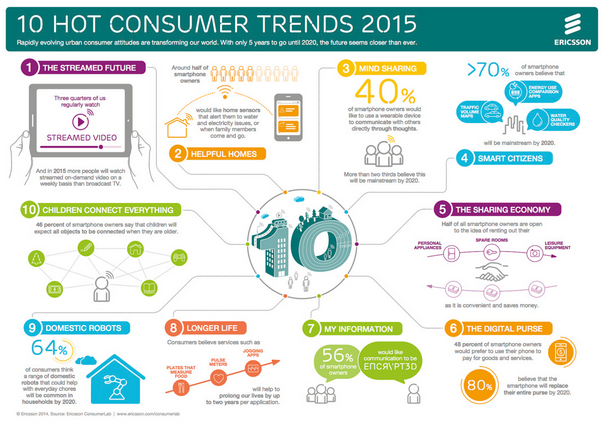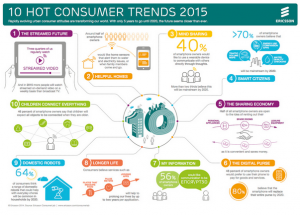- Ericsson ConsumerLab’s annual report shows that consumers want technology and connectivity to be integrated into all facets of daily life – in everything from bathroom mirrors, to sidewalks and medicine jars
- Consumers are becoming more comfortable with ideas that once seemed beyond imagination – like robots in the home and mind sharing
- In 2015, consumers will watch streamed video more often than broadcast TV
The end of 2014 is approaching, and Ericsson ConsumerLab can now, in the fourth edition of its annual trend report, present the hottest consumer trends for 2015 and beyond.
Elie Hanna, President and Country Manager for Ericsson Philippines and Pacific Island, says: “The cumulative effect of smartphones becoming part of mainstream society is astonishing. As consumers, we try out new apps and keep the ones we think improve, enrich or even prolong our lives at such a rapid pace that we don’t even notice that our attitudes and behaviors are changing faster than ever. Services and products that quite recently seemed beyond imagination are now easily accepted and believed to rapidly reach the mass market. With only five years until 2020, the future really does seem closer than ever before.”
The insights in the report “10 hot consumer trends for 2015 and beyond” come from Ericsson ConsumerLab’s global research program, with a special focus this year on smartphone owners aged 15 to 69 in Johannesburg, London, Mexico City, New York, Moscow, San Francisco, Sâo Paulo, Shanghai, Sydney and Tokyo – statistically representing the views of 85 million frequent internet users.
These are the 10 hot consumer trends for 2015 and beyond:
- The streamed future. Media use patterns are globalizing. Viewers are shifting towards easy-to-use on-demand services that allow cross-platform access to video content. 2015 will be historic as more people will watch streamed video on a weekly basis than broadcast TV. In Philippines, 22 percent of regular Internet users stated that most of their TV/ video viewing is on-demand or online while 21 percent stated that most of their TV/ video viewing is through TV channels.
- Helpful homes. Consumers show high interest in having home sensors that alert them to water and electricity issues, or when family members come and go. In the Philippines, nearly 40% of regular Internet users said they were interested in the concept of a Connected Home.
- Mind sharing. New ways to communicate will continue to appear, offering us even more ways to keep in touch with our friends and family. Many smartphone owners would like to use a wearable device to communicate with others directly through thought – and believe this will be mainstream by 2020. One-third of all Philippine respondents said that they would be interested to use wearable devices.
- Smart citizens. The idea of smart cities is intriguing – but a lot of that intelligence may actually come about as a side effect of the changing everyday behaviors of citizens. As the internet makes us more informed, we are in turn making better decisions. Consumers believe traffic volume maps, energy use comparison apps and real-time water quality checkers will be mainstream by 2020.
- The sharing economy. As the internet enables us to efficiently share information with unprecedented ease, the idea of a sharing economy is potentially huge. Half of all smartphone owners are open to the idea of renting out their spare rooms, personal household appliances and leisure equipment as it is convenient and can save money.
- The digital purse. 48 percent of smartphone owners would rather use their phone to pay for goods and services. 80 percent believe that the smartphone will replace their entire purse by 2020.
- My information. Although sharing information when there is a benefit is fine, smartphone owners see no point in making all of their actions open to anyone. 47 percent of smartphone owners would like to be able to pay electronically without an automatic transfer of personal information. 56 percent of smartphone owners would like all internet communication to be encrypted. In the Philippines, while only 10% of the respondents surveyed said that they currently use mobile payment systems, nearly 70% of the respondents said that they will be encouraged to buy online if there are flexible, secure payment options.
- Longer life. Smartphone owners see cloud-based services of various kinds giving them the potential to live healthier and longer lives. Jogging apps, pulse meters and plates that measure our food are believed to help prolong our lives by up to two years per application.
- Domestic robots. Consumers are welcoming the idea of having domestic robots that could help with everyday chores. 64 percent also believe this will be common in households by 2020.
- Children connect everything. Children will continue to drive the demand for a more tangible internet, where the physical world is as connected as the screens of their devices. 46 percent of smartphone owners say that children will expect all objects to be connected when they are older.
NOTES TO EDITORS
Link to the report
Link to video
Link to infographic
Link to PPT
About Ericsson ConsumerLab
Ericsson ConsumerLab has close to 20 years’ experience of studying people’s behaviors and values, including the way they act and think about ICT products and services. Ericsson ConsumerLab provides unique insights on market and consumer trends.
Ericsson ConsumerLab gains its knowledge through a global consumer research program based on interviews with 100,000 individuals each year, in more than 40 countries and 15 megacities – statistically representing the views of 1.1 billion people. Both quantitative and qualitative methods are used, and hundreds of hours are spent with consumers from different cultures.
Download high-resolution photos and broadcast-quality video at www.ericsson.com/press
Ericsson is the driving force behind the Networked Society – a world leader in communications technology and services. Our long-term relationships with every major telecom operator in the world allow people, businesses and societies to fulfill their potential and create a more sustainable future.
Our services, software and infrastructure – especially in mobility, broadband and the cloud – are enabling the telecom industry and other sectors to do better business, increase efficiency, improve the user experience and capture new opportunities.
With more than 110,000 professionals and customers in 180 countries, we combine global scale with technology and services leadership. We support networks that connect more than 2.5 billion subscribers. Forty percent of the world’s mobile traffic is carried over Ericsson networks. And our investments in research and development ensure that our solutions – and our customers – stay in front.
Founded in 1876, Ericsson has its headquarters in Stockholm, Sweden. Net sales in 2013 were SEK 227.4 billion (USD 34.9 billion). Ericsson is listed on NASDAQ OMX stock exchange in Stockholm and the NASDAQ in New York.
www.ericsson.com
www.ericsson.com/news
www.twitter.com/ericssonpress
www.facebook.com/ericsson
www.youtube.com/ericsson
FOR FURTHER INFORMATION, PLEASE CONTACT
Ellen Alarilla
Phone: +63908 886 3789
E-mail: ellen.alarilla@ericsson.com


